Flies, Fly Screens & Fly Killers
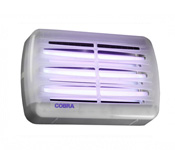
Electronic Fly Killers
Pest Defence Ltd supplies a wide range of Electronic Fly Killers suited to every situation and budget. Our range includes both glueboard fly killers and electrifying fly killers for all food preparation areas including restaurants, food retailers, canteens, factories, and homes. Electronic fly killers are effective and hygienic devices designed to remove flying insects without use of insecticides wherever they are not wanted, whether it be to prevent diseases, contamination, or just the nuisance they can cause.
The fly killer that is best suited to your circumstances depends upon the place and purpose of use, the area of coverage, and importantly, the positioning of the fly killer. We strongly recommend that you call Pest Defence for our expert advice before purchasing an electronic fly killer to ensure that the chosen model is the most effective and efficient for the purpose.
Pest Defence Electronic Fly Killer Specification & Service
Features
- Pest Defence supply both Electronic and Glueboard Fly Killers.
- Pest Defence supply electronic fly killers for the control of Cluster Fly in lofts and voids.
- Available for Purchase or Hire (short or long term)
- Available in white steel, stainless steel, or white plastic construction.
- Three year guarantee on some models.
Electronic Fly Killers
- Pest Defence provides a full service package including the essential requirements of regular cleaning and annual replacement of Ultra Violet (UV) lamps. This service is included for all fly killers supplied on hire by Pest Defence Ltd.
- Pest Defence supplies ALL types of Ultra Violet lamps available in the UK for fly killers, including standard UV lamps, shatterproof UV lamps, high performance Quantum UV lamps (blue), and high performance synergetic UV lamps (green).
- Pest Defence supplies ALL types of glueboards and sticky rolls for glueboard fly killers.
- Pest Defence can supply a range of replacement parts for the repair and maintenance of most electronic fly killers.
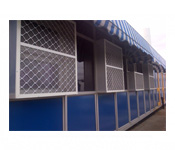
Fly Screen Windows & Doors
Pest Defence Ltd supplies a wide range of Fly Screen Windows and Doors for every situation and budget. We offer a range of high standard fly screening systems that are designed to provide effective and hygienic fly screening, ease of use, and value for money.
The fly screening system that is best suited to your circumstances depends upon the place and purpose of use, and the level of activity. We strongly recommend that you call Pest Defence for our expert advice before purchasing fly screening to ensure that the chosen fly screen products are the most effective and efficient for the purpose.
Pest Defence Fly Screen Windows & Doors Specification and Service
Features
- Pest Defence supplies Fly Screen Windows and Doors suitable for commercial, industrial and domestic environments.
- Window and Door frames are available in white steel or stainless steel.
- Fly screens can be installed internally or externally.
- Fly screen mesh is available in standard PVC coated fibreglass mesh, stainless steel mesh, or aluminium mesh.
Sale and Service of Fly Screen Windows and Doors
- Pest Defence provides a free of charge survey to visit your premises and recommend the best product for you. An on-site survey is always necessary in order to take accurate measurements for an accurate quotation.
- Types of fly screen windows and doors include:
- Double slider fly screen windows
- Side hinged fly screen windows
- Fixed fly screen windows
- External canopy fly screens
- Standard fly screen mesh doors
- Heavy Duty fly screen mesh doors
- Fly screen patio doors
- UPV strip curtain doors (solid and perforated strips available)
- Pest Defence provides a repair service for existing fly screen windows and doors.
- Chain link fly screen doors.
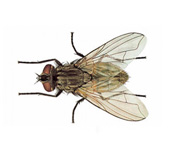
Common House Fly
The Common House Fly is a seriousness pest of public health importance and is known to be responsible for many outbreaks of food poisoning disease such as Salmonellosis and Gastroenteritis. They can also transmit intestinal worms.
House Flies feed by regurgitating their stomach contents onto the food and then sucking up the liquid soup of digested food material. In doing so the flies transmit pathogenic organisms from refuse areas and animal faeces onto food destined for human consumption. Flies will also tread bacteria into the food and they are also constantly defecating themselves. No wonder they are such an unwanted food pest.
Biology
The adult flies are grey in colour and approximately 6-8mm long with a wingspan of 13-15mm. The eggs are laid in batches of 100-150 in decaying organic material, particularly in household refuse and compost. The eggs hatch within 8-48 hours into small legless maggots which grow to size of 10-12mm before pupating and hatching as the adult fly. Under ideal conditions it can take as little as one week to complete its life cycle.
Pest Control
Removal and exclusion of breeding sites, such as refuse areas is important in the control of flies, and the prevention of ingress by flies into food production areas is essential. Electronic fly killers should also be employed to eliminate any flies that manage to enter the food production area.
‘Regulation (EC) No. 852/2004 on the hygiene of foodstuffs’ states that windows, doors and other openings that can be opened to the outside must, where necessary, be fitted with insect-proof screens that can be easily removed for cleaning.
Pest Defence pest control experts will provide advice and recommendations, free of charge, for measures necessary to control fly activity at your home or business, including recommendations for the installation of fly killers and fly screen windows and doors/
Pest Defence also provide insecticidal fly control services for industry and commercial applications such as refuse and landfill sites.
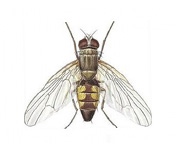
Lesser House Fly
Lesser House Flies are similar in appearance to the Common House Fly but as the name suggests they are smaller. The adult flies are approximately 6 mm long with 12 mm wingspan. They have an erratic flight pattern and are often seen flying in large numbers around indoor light fittings. The Lesser Housefly is more tolerant of cool conditions than the Common Housefly.
Biology
Lesser Housefly prefer a semi-liquid organic sludge in which their eggs and larvae develop. Ideal breeding sites are often found in the semi-liquid slurry of poultry and animal manure. Larval development occurs in at least 8 days and they have 3 skin moults. The lifecycle from egg to adult takes about 3 weeks in ideal conditions.
Pest Control
Good hygiene and refuse management is necessary to prevent potential breeding sites and food sources. Entry of adult flies into buildings can be prevented by fly-screening doors and windows and insecticidal applications are available for fly control in domestic, commercial and agricultural situations.
Pest Defence pest control experts will provide advice and recommendations, free of charge, for measures necessary to control fly activity at your home or business, including recommendations for the installation of fly killers and fly screen windows and doors.
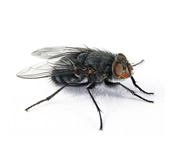
Blowflies
Blowflies including Bluebottle and Greenbottle flies are large flies with either a black or iridescent metallic colouration. The presence of large numbers of blowfly is often indicative of the presence of a dead animal upon which they have bred, although sometimes it is the result of poor refuse management and collection.
Biology
Blow flies lay their eggs on dead animals, meatfish refuse, and animal dung within which they feed until mature. The larvae then migrate to a dark dry place where they pupate and hatch into the adult fly. At room temperature (about 20 °C), the devopment from egg to adult can occur in 6-11 days.
Pest Control
Good hygiene and refuse management is necessary to prevent potential breeding sites and food sources. Entry of adult flies into buildings can be prevented by fly-screening doors and windows and electronic fly killers are very effective at attracting and eliminating blowflies.
Should Blowflies, Bluebottle Flies or Greenbottle Flies become abundant, a careful search for the larval breeding areas should be made, which could be an animal or bird carcass or food waste. The necessary housekeeping or maintenance measures should be undertaken and any lingering adult flies may be controlled by the use of a residual insecticide or ULV treatment or the employment of an electronic fly killer.
Pest Defence pest control experts will provide advice and recommendations, free of charge, for measures necessary to control fly activity at your home or business, including recommendations for the installation of electronic fly killers and fly screen windows and doors.
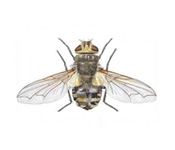
Cluster Fly
The Common Cluster Fly (Pollenia rudis) is often confused with the House Flies, but at about 9mm long, it is slightly larger than the Common Housefly. The thorax is dark olive grey, with fine golden hairs which can easily be rubbed off and there are no distinct lines or stripes behind the head and the abdomen has irregular light and dark grey areas.
The Cluster Fly lives outdoors through the summer but can be a serious nuisance to homeowners and businesses during Autumn, Winter and Spring months when they enter buildings in large numbers for the purpose of hibernation (hence the name Cluster Fly). Typically they are more prevalent in rural and semi-rural environments where there is an abundance of nearby pasture or grassland, and they enter the higher levels of the buildings including the loft.
Biology
Cluster Flies (Pollenia rudis) have an unusual life cycle in that the larvae are parasitic on earthworms. The adult flies lay their eggs in the soil and the larvae search for earthworms. The adult flies feed on pollen and nectar during the summer and are not a fly of public health importance. As winter approaches, the adult flies seek protected places to spend the winter and in many cases will find shelter within walls, roof voids attics, and window frames, favouring the South facing elevations of the building that are warmed by the sun. The ingress of flies occurs predominantly during sunny days in September and October and this is when they are most noticeable, although Cluster Fly can be problematic at any time during Autumn, Winter and again in Spring. The main problem occurs when they enter the living areas of homes and businesses being attracted to light warmth, often in large numbers. The flies will naturally head for the windows where people can find large numbers of dead and dying flies on a daily basis. Buildings susceptible to Cluster Fly problems will usually have a reoccurring problem every winter.
Another species of cluster fly commonly encountered in the UK is the Yellow Swarming Cluster Fly which is much smaller (3mm body length) and occurs in large numbers of swarming flies.
Pest Control
Complete control of cluster flies is almost impossible since many of the over wintering adults are concealed in wall voids, lofts and attics, and because the ingress and exit of flies occurs repeatedly during the Autumn to Spring period. However, the problem can be significantly alleviated by treating lofts and voids with an approved insecticidal space treatment in the Autumn when the majority of flies are entering. Electronic fly killers can also be employed at this time to capture the large numbers of flies that are entering the building, and in some circumstances we will recommend that holes and gaps be sealed, and loose fitting loft hatches be secured to restrict the movement of Cluster Flies.
Pest Defence pest control experts will provide advice and recommendations, free of charge, for measures necessary to control and prevent problems with Cluster Fly at your home or business, including recommendations for the employment of electronic fly killers and proofing where applicable.
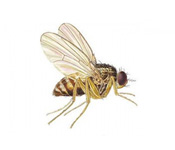
Fruit Flies
Adult Fruit Flies (Drosophila sp) are very small insects, about 3mm long. The body colour is usually a light yellow to tan colour and the abdomen is grey underneath and a common characteristic of fruit flies is distinctive red eyes.
Biology
Fruit Flies breed in fermenting organic matter such as rotting fruit, fermenting juices, soured milk etc, onto which they lay their eggs. Fruit fly larvae feed on the yeast organisms and fungi growing in the fruit and vegetable materials. Through their feeding efforts, they soon turn their food into a semi-liquid mess and given their biology, they are a common pest in pubs and commercial kitchens.
Pest Control
Should fruit flies become abundant, a careful search for the larval breeding site should be made, and the infested material must be removed once found. Any lingering adult flies may be controlled by the use of a residual insecticide or ULV treatment.
Pest Defence pest control experts are experienced and qualified to identify fruit fly infestations and recommend a safe and effective solution to your fly problem.
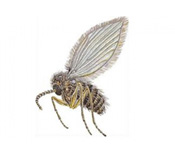
Drain & Filter Flies
Filter Flies (Psychodidae) are small light coloured hairy flies of length 2mm with almond shaped wings. They are frequently mistaken for small moths since the wings are held roof-like over the body when at rest. They are weak fliers and often appear to be jumping or hopping.
Drain or Dung (Sphaeroceridae sp) Flies are small black coloured flies of body length up to 5mm , with wings that are typically longer than the body. They are good fliers but often appear to be jumping or hopping.
Biology
Filter flies and drain flies are often associated with moist, highly organic areas such as sink drains, sewage treatment facilities, storm drains, dung and rotten vegetation. They are sometimes indicative of faults in sewers where they are breeding in effluent sludge. Female can produce about 100 eggs and, under optimum conditions, development can be completed in two weeks.
Pest Control
Should Drain or filter flies become abundant, a careful search for the larval breeding areas should be made, and the necessary housekeeping or maintenance measures taken. Any lingering adult flies may be controlled by the use of a residual insecticide or ULV treatment.
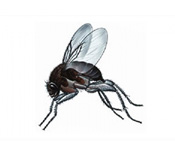
Phorid Fly
Phorid Flies are small flies, measuring up to 3mm in length.. The most prominent feature of this fly is the humpbacked shape of its thorax. The Phorid fly is similar in size to the fruit fly but lacks the red eye colour that is the classic trademark of the fruit fly.
Biology
The phorid fly breeds and feeds primarily on moist decaying organic matter. The reproductive potential of these flies is tremendous and very large numbers of them may appear in a short time. Phorid flies are common flies and are a serious pest when found in food producing, food handling or food serving facilities. Fermenting materials such as fruit, dirty garbage containers, rotten vegetables or slime in drains are just a few of their favourite breeding and feeding places. The life cycle from egg to adult can be completed in as little as 14 days (under ideal conditions).
Pest Control
The key to controlling phorid fly infestations is a positive identification and the identification and elimination of their breeding sources.
Pest Defence pest control experts will identify the nature and extent of your pest problems and recommend a safe and effective solution to your fly problem.
Without the proper preventative measures in place, flies can wreak havoc on homes or businesses. Infestation in catering businesses, pubs, restaurants or kitchens can be extremely concerning due to the risk of food contamination.
The team at Pest Defence are committed to ridding your establishment of all flying pests, whether it be house flies, blowflies, or any type of fly. We achieve this first through assessment of your property and identification of the types of fly we’re dealing with. Next, our fly exterminators will use their years of experience to determine which fly control methods will best remove the flies swiftly and safely.
We offer top-of-the-range electric fly killers as our primary method of fly removal. These installations are favoured particularly in food environments due to the lack of pesticides and chemicals involved. For other environments, including domestic properties, UV lamps, glue boards and insecticides may be the preferred option.
Our service doesn’t stop there. We’ll also provide advice and preventative measures to stop an infestation from recurring in the future. Our fly screens are the most popular method of achieving this. Simple application onto windows and doors will effortlessly and hygienically screen insects to deny them entry into the premises.
For the best fly control and fly removal services throughout Colchester, Chelmsford, Brentwood and other areas in Essex, give our friendly team a call today. All our pest control services can be undertaken the very same day as enquiry, and we’ll never charge more than the quote agreed over the phone.







